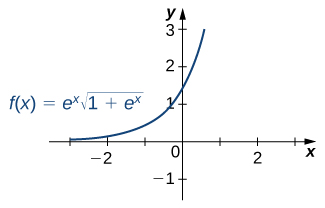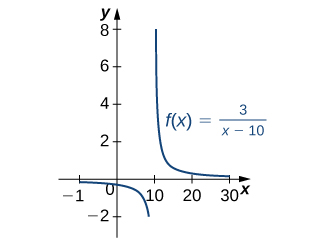Section 5.5 The Definite Integral
Learning Objectives.
Use substitution to evaluate indefinite integrals.
Use substitution to evaluate definite integrals.
The Fundamental Theorem of Calculus gave us a method to evaluate integrals without using Riemann sums. The drawback of this method, though, is that we must be able to find an antiderivative, and this is not always easy. In this section we examine a technique, called integration by substitution, to help us find antiderivatives. Specifically, this method helps us find antiderivatives when the integrand is the result of a chain-rule derivative.
At first, the approach to the substitution procedure may not appear very obvious. However, it is primarily a visual task—that is, the integrand shows you what to do; it is a matter of recognizing the form of the function. So, what are we supposed to see? We are looking for an integrand of the form \(f(g(x))g'(x)dx.\) For example, in the integral \(\displaystyle{ \int (x^2-3)^3 2xdx},\) we have \(f(x)=x^3,g(x)=x^2-3,\) and \(g'(x)=2x.\) Then,
and we see that our integrand is in the correct form.
The method is called substitution because we substitute part of the integrand with the variable \(u\) and part of the integrand with \(du\text{.}\) It is also referred to as change of variables because we are changing variables to obtain an expression that is easier to work with for applying the integration rules.
Subsection 5.5.1 Substitution with Indefinite Integrals
Theorem 5.81. Substitution with Indefinite Integrals.
Let \(u=g(x),,\) where \(g'(x)\) is continuous over an interval, let \(f(x)\) be continuous over the corresponding range of \(g\text{,}\) and let \(F(x)\) be an antiderivative of \(f(x).\) Then,
Returning to the problem we looked at originally, we let \(u=x^2-3\) and then \(du=2xdx.\) Rewrite the integral in terms of \(u\text{:}\)
Using the power rule for integrals, we have
Substitute the original expression for \(x\) back into the solution:
We can generalize the procedure in the following Problem-Solving Strategy.
Note 5.82. Problem-Solving Strategy: Integration by Substitution.
Look carefully at the integrand and select an expression \(g(x)\) within the integrand to set equal to \(u\text{.}\) Let’s select \(g(x).\) such that \(g'(x)\) is also part of the integrand.
Substitute \(u=g(x)\) and \(du=g'(x)dx.\) into the integral.
We should now be able to evaluate the integral with respect to \(u\text{.}\) If the integral can’t be evaluated we need to go back and select a different expression to use as \(u\text{.}\)
Evaluate the integral in terms of \(u\text{.}\)
Write the result in terms of \(x\) and the expression \(g(x).\)
Example 5.83. Using Substitution to Find an Antiderivative.
Use substitution to find the antiderivative of \(\displaystyle{ \int 6x (3x^2+4)^4 dx}.\)
The first step is to choose an expression for \(u\text{.}\) We choose \(u=3x^2+4.\) because then \(du=6xdx.,\) and we already have \(du\) in the integrand. Write the integral in terms of \(u\text{:}\)
Remember that \(du\) is the derivative of the expression chosen for \(u\text{,}\) regardless of what is inside the integrand. Now we can evaluate the integral with respect to \(u\text{:}\)
Analysis
We can check our answer by taking the derivative of the result of integration. We should obtain the integrand. Picking a value for \(C\) of 1, we let \(y=\frac{1}{5}(3x^2+4)^5+1.\) We have
so
This is exactly the expression we started with inside the integrand.
Checkpoint 5.84.
Use substitution to find the antiderivative of \(\displaystyle{ \int 3x^2(x^3-3)^2dx}.\)
Sometimes we need to adjust the constants in our integral if they don’t match up exactly with the expressions we are substituting.
Example 5.85. Using Substitution with Alteration.
Use substitution to find the antiderivative of \(\displaystyle{ \int z\sqrt{z^2-5}dz}.\)
Rewrite the integral as \(\displaystyle{ \int z(z^2-5)^{1/2}dz}.\) Let \(u=z^2-5\) and \(du=2z dz.\) Now we have a problem because \(du=2z dz\) and the original expression has only \(z dz.\) We have to alter our expression for \(du\) or the integral in \(u\) will be twice as large as it should be. If we multiply both sides of the \(du\) equation by \(\frac{1}{2}.\) we can solve this problem. Thus,
Write the integral in terms of \(u\text{,}\) but pull the \(\frac{1}{2}\) outside the integration symbol:
Integrate the expression in \(u\text{:}\)
Checkpoint 5.86.
Use substitution to find the antiderivative of \(\displaystyle{ \int x^2(x^3+5)^9dx}.\)
Example 5.87.
Use substitution to evaluate the integral \(\displaystyle{ \int\frac{t^2+1}{(t^3+3t+1)^4}dt}.\)
We know the derivative of \(t^3+3t+1\) is \(3t^2+3,\) so we set \(u=t^3+3t+1.\) Then \(du=(3t^2+3)dt.\) Moreover, \(\frac{1}{3}du=(t^2+1)dt.\) Substituting into the integral, we have
Evaluating the integral, we get
Putting the answer back in terms of \(t\text{,}\) we get
Checkpoint 5.88.
Use substitution to evaluate the integral \(\displaystyle{ \int (t+1)(t^2+2t)^7 dt.}\)
Subsubsection 5.5.1.1 Indefinite Integrals Involving Exponential and Logarithmic Functions
Example 5.89.
Find the antiderivative of the exponential function \(e^{-x}\text{.}\)Checkpoint 5.90.
Find the antiderivative of the function using substitution: \(x^2e^{-2x^3}\text{.}\)A common mistake when dealing with exponential expressions is treating the exponent on e the same way we treat exponents in polynomial expressions. We cannot use the power rule for the exponent on e. This can be especially confusing when we have both exponentials and polynomials in the same expression, as in the previous checkpoint. In these cases, we should always double-check to make sure we’re using the right rules for the functions we’re integrating.
Example 5.91. Square Root of an Exponential Function.
Find the antiderivative of the exponential function \(e^x\sqrt{1+e^x}\text{.}\)First rewrite the problem using a rational exponent:
Using substitution, chose \(u=1+e^x\text{.}\) Then, \(du=e^x dx\text{.}\) We have (Figure 5.92)

Checkpoint 5.93.
Find the antiderivative of \(e^x(3e^x-2)^2\text{.}\)Example 5.94. Find an Antiderivative Involving \(\ln x\).
Find the antiderivative of the function \(\frac{3}{x-10}\text{.}\)First factor the 3 outside the integral symbol. Then use the \(u^{-1}\) rule. Thus,
See Figure 5.95.

Checkpoint 5.96.
Find the antiderivative of \(\frac{1}{x+2}\text{.}\)Example 5.97. Finding an Antiderivative of a Rational Function.
Find the antiderivative of \(\frac{2x^3+3x}{x^4+3x^2}\text{.}\)Use substitution. Let \(u=x^4+3x^2\text{,}\) then \(du=4x^3+6x\text{.}\) Alter \(du\) by factoring out the 2. Thus,
Rewite the integrand in \(u\text{:}\)
Exponential functions are used in many real-life applications. The number e is often associated with compounded or accelerating growth, as we have seen in earlier sections about the derivative. Although the derivative represents a rate of change or a growth rate, the integral represents the total change or the total growth. Let's look at an example in which integration of an exponential function solves a common business application.
A price-demand function tells us the relationship between the quantity of a product demanded and the price of the product. In general, price decreases as quantity demanded increases. The marginal price-demand function is the derivative of the price-demand function and it tells us how fast the price changes at a given level of production. These functions are used in business to determine the price-elasticity of demand, and to help companies determine whether changing production levels would be profitable.
Example 5.98. Finding a Price-Demand Equation.
Find the price-demand equation for a particular brand of toothpaste at a supermarket chain when the demand is 50 tubes per week at $2.35 per tube, given that the marginal price-demand function, \(p'(x)\text{,}\) for \(x\) number of tubes per week, is given asTo find the price-demand equation, integrate the marginal price-demand function. First find the antiderivative, then look at the particulars. Thus,
Using substitution, let \(u=-0.01\text{ and } du=-0.01 dx.\) Then, divide both sides of the \(du\) equation by -0.01. This gives
The next step is to solve for C. We know that when the price is $2.35 per tube, the demand is 50 tubes per week. This means
If the supermarket sells 100 tubes of toothpaste per week, the price would be
The supermarket should charge $1.99 per tube if it is selling 100 tubes per week.
Checkpoint 5.99. Average Future Value of an Account Continuously Compounded.
An account with initial amount of $2000 is compounded continuosly at an annual rate of 10% per year. What is the average amount of money in the account over the first 8 years?[cross-reference to target(s) "Average-Value_5.2" missing or not unique] and to find the future value of an account continuously compounded use [cross-reference to target(s) "Compounded-Continuously_1.5" missing or not unique].Sometimes we need to manipulate an integral in ways that are more complicated than just multiplying or dividing by a constant. We need to eliminate all the expressions within the integrand that are in terms of the original variable. When we are done, \(u\) should be the only variable in the integrand. In some cases, this means solving for the original variable in terms of \(u\text{.}\) This technique should become clear in the next example.
Example 5.100. Finding an Antiderivative Using \(u\)-Substitution.
Use substitution to find the antiderivative of \(\displaystyle{ \int \frac{x}{\sqrt{x-1}}dx.}\)
If we let \(u=x-1,\) then \(du=dx.\) But this does not account for the \(x\) in the numerator of the integrand. We need to express \(x\) in terms of \(u\text{.}\) If \(u=x-1,\) then \(x=u+1.\) Now we can rewrite the integral in terms of \(u\text{:}\)
Then we integrate in the usual way, replace \(u\) with the original expression, and factor and simplify the result. Thus,
Checkpoint 5.101.
Use substitution to evaluate the indefinite integral \(\displaystyle{ \int\frac{t^2}{\sqrt{t-1}} dt}.\)
Use the process from Example 5.100 to solve the problem.
\(\frac{2}{5}\sqrt{(t-1)^5}+\frac{4}{3}\sqrt{(t-1)^3}+2\sqrt{t-1}+C\)
Subsection 5.5.2 Substitution for Definite Integrals
Substitution can be used with definite integrals, too. However, using substitution to evaluate a definite integral requires a change to the limits of integration. If we change variables in the integrand, the limits of integration change as well.
Theorem 5.102. Substitution with Definite Integrals.
Let \(u=g(x)\) and let \(g'\) be continuous over an interval \([a,b],\) and let \(f\) be continuous over the range of \(u=g(x).\) Then,
Although we will not formally prove this theorem, we justify it with some calculations here. From the substitution rule for indefinite integrals, if \(F(x)\) is an antiderivative of \(f(x),\) we have
Then
and we have the desired result.
Example 5.103. Using Substitution to Evaluate a Definite Integral.
Use substitution to evaluate \(\displaystyle{ \int_{0}^{1} x^2(1+2x^3)^5}dx.\)
Let \(u=1+2x^3,\) so \(du=6x^2dx.\) Since the original function includes one factor of \(x^2\) and \(du=6x^2dx,\) multiply both sides of the \(du\) equation by \(1/6.\) Then,
To adjust the limits of integration, note that when \(x=0,u=1+2(0)=1,\) and when \(x=1,u=1+2(1)=3.\) Then
Evaluating this expression, we get
Checkpoint 5.104.
Use substitution to evaluate the definite integral \(\displaystyle{ \int_{-1}^{0}y(2y^2-3)^5dy}.\)
Subsubsection 5.5.2.1 Definite Integrals Involving Exponential and Logarithmic Functions
Example 5.105. Using Substitution with an Exponential Function.
Use substitution to evaluate \(\displaystyle{ \int_{0}^{1} xe^{4x^2+3}dx}.\)
Let \(u=4x^3+3.\) Then, \(du=8xdx.\) To adjust the limits of integration, we note that when \(x=0,u=3,\) and when \(x=1,u=7.\) So our substitution gives
Checkpoint 5.106.
Use substitution to evaluate \(\displaystyle{ \int_{0}^{1} (x^3+1)e^{x^4+4x+3} dx}.\)
Use the process from Example 5.105 to solve the problem.
\(\frac{1}{4}(e^8-e^3)\approx 740.218\)
Example 5.107.
EvaluateLet \(u=2x+1.\) Then, \(du=2dx.\) To adjust the limits of integration, we note that when \(x=A,\;u=2A+1,\) and when \(x=4,\;u=9.\) So our substitution gives
Substitution may be only one of the techniques needed to evaluate a definite integral. All of the properties and rules of integration apply independently, and trigonometric functions may need to be rewritten using a trigonometric identity before we can apply substitution. Also, we have the option of replacing the original expression for \(u\) after we find the antiderivative, which means that we do not have to change the limits of integration.
Subsection 5.5.3 Key Concepts
Substitution is a technique that simplifies the integration of functions that are the result of a chain-rule derivative. The term ‘substitution’ refers to changing variables or substituting the variable \(u\) and \(du\) for appropriate expressions in the integrand.
When using substitution for a definite integral, we also have to change the limits of integration.
Subsection 5.5.4 Key Equations
Substitution with Indefinite Integrals
\begin{equation*} \displaystyle{ \int f(g(x))g'(x)dx=\displaystyle{ \int f(u)du}}=F(u)+C=F(g(x))+C \end{equation*}Substitution with Definite Integrals
\begin{equation*} \displaystyle{ \int_{a}^{b} f(g(x))g'(x)dx}=\displaystyle{ \int_{g(a)}^{g(b)}f(u)du} \end{equation*}